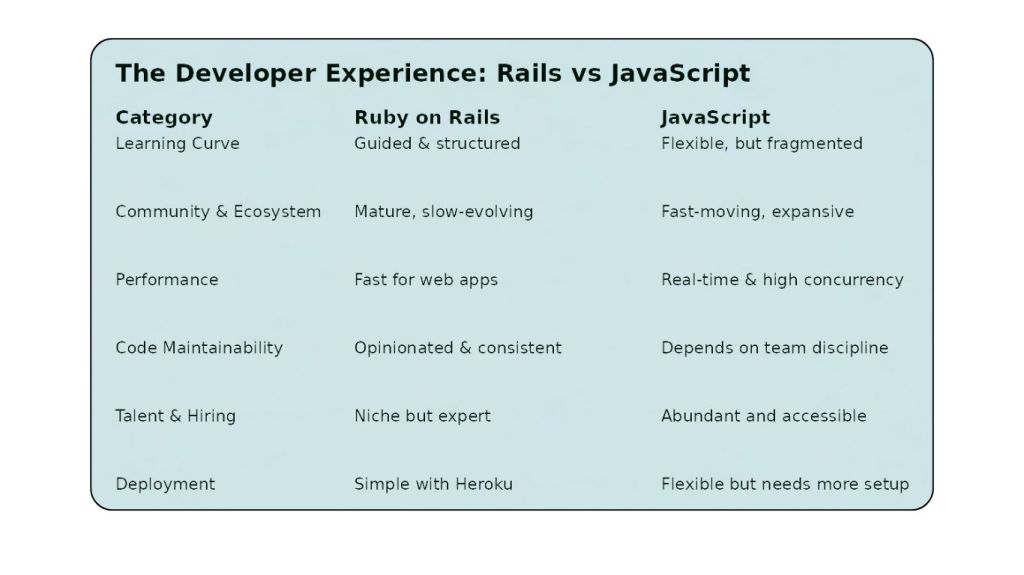When it comes to web development, you’ve got options—lots of them. But one comparison that often trips people up is Ruby on Rails vs. JavaScript. It’s a bit of a trick question because you’re comparing a framework with a programming language, but it’s still an important conversation when you’re deciding how to build your product.
Let’s unpack what each offers, where they shine, and when one might be a better fit than the other.
What is Ruby on Rails?
Ruby on Rails is a full-stack web framework built with the Ruby programming language. It follows the Model-View-Controller (MVC) architecture and is known for its philosophy of “convention over configuration.” In other words, Rails handles a lot of decisions for you—speeding up development and making it easier to focus on your product.
This framework is especially attractive to startups or small teams looking to launch quickly. It’s got a curated feel to it, offering built-in tools for routing, database interactions (via ActiveRecord), background jobs, and even security features like CSRF protection—all out of the box.
Rails is also appreciated for its readable syntax and maintainability, which means clean codebases that are easier to support long-term—even as teams grow or change.
What About JavaScript?
JavaScript is a full-fledged programming language—one that runs on both the frontend and backend. Originally built for web browsers, JavaScript has evolved into a major player in full-stack development thanks to tools like Node.js.
JavaScript is incredibly flexible. You can build just about anything with it—from server-side APIs to real-time dashboards and single-page applications. The ecosystem includes popular libraries and frameworks like React, Vue, Express, and Next.js.
Its performance is another strength. JavaScript’s event-driven architecture and non-blocking I/O make it ideal for apps that demand real-time updates or need to support a high number of concurrent users.
Rails vs JavaScript – Side-by-Side
| Feature |  |  |
|---|---|---|
| Language | Ruby | JavaScript |
| Stack Type | Backend (can include views) | Full-stack (frontend + backend) |
| Learning Curve | Steep at first, but fast productivity | Familiar syntax, more setup needed |
| Development Speed | Very fast for MVPs | Fast runtime, more manual configuration |
| Performance | Slightly slower runtime | Excellent for real-time performance |
| Community | Passionate, tightly knit | Massive, fast-evolving |
| Ecosystem | Opinionated and curated | Diverse but fragmented |
| Use Cases | SaaS, CMS, admin tools | Real-time apps, modern UIs |
| Hosting Options | Heroku, AWS, Render | Vercel, AWS, Netlify, etc. |
👋 Not sure which tech stack fits your project best?
Tell us a bit about your goals and we’ll help you evaluate the right path forward—whether that’s Rails, JavaScript, or a hybrid solution.
Trusted by tech leaders at:



Learning Curves: More Than Just Syntax

Learning Rails may feel intimidating at first, especially if you’re not familiar with Ruby. But once you dive in, the framework provides guardrails that make it easier to learn best practices as you build. Rails also includes built-in testing frameworks, reducing the need to hunt for tools before you can write reliable code.
JavaScript is more familiar to many developers, especially those coming from the frontend. But going full-stack often means stitching together multiple tools—frontend libraries, backend frameworks, state management, and more. That flexibility is powerful but can increase complexity for beginners or small teams.
Community and Ecosystem
Rails has a long-standing, stable community with a deep well of documentation, gems (plugins), and open-source tools. Its development pace is steady, which helps with long-term maintainability and stability.
JavaScript’s ecosystem, on the other hand, evolves rapidly. That speed allows for constant innovation, but it also means tools can become outdated quickly. While there’s tremendous energy in the JS space, it also requires more vigilance to keep up with evolving standards and dependencies.
Performance and Scalability
Rails isn’t built for handling thousands of real-time connections out of the box, but for most web application workloads—especially traditional, form-driven UIs—it’s fast, consistent, and efficient.
JavaScript, especially through Node.js, handles high-concurrency, low-latency environments with ease. It’s asynchronous by nature, making it a strong choice for anything involving real-time messaging, streaming, or event-driven architecture
Code Maintainability
Rails is structured in a way that promotes clean, consistent code across teams. Its opinionated design may feel restrictive at first, but it ensures that projects stay organized and readable, even as complexity grows.
JavaScript can also be clean and scalable—but it depends more on developer discipline and chosen frameworks. With multiple ways to do the same thing, team conventions become more important.
Talent and Hiring
JavaScript developers are generally easier to find, given that it’s taught widely and used on both the frontend and backend. This can simplify hiring, especially for startups building cross-functional teams.
Rails developers, while more niche, often bring a high level of expertise in building and scaling structured web apps. If you’re building a SaaS platform or enterprise-grade app, Rails teams can get you up and running quickly—and maintain that stability long term.
Hosting and Deployment
Rails pairs exceptionally well with platforms like Heroku, which makes deployment and scaling a breeze—especially for smaller teams without DevOps resources.
JavaScript projects have a broader deployment surface. Modern hosting platforms like Vercel and Netlify are optimized for frontend frameworks, and Node-based APIs can run on AWS Lambda, DigitalOcean, or any containerized service. It may require more configuration, but it offers a lot of flexibility.

When to Choose Rails
- ⚡ Speed to market: You need to build and launch quickly (think MVPs and internal tools)
- 🧭 Convention over configuration: You prefer structure and guidance instead of starting from scratch
- 🧼 Clean codebase: You want a maintainable, well-organized project long-term
- 🚫 Not real-time heavy: Your app doesn’t rely on real-time interactions like chat or live updates
- 🧰 Built-in features: You want ready-to-use tools like authentication, background jobs, admin panels
When to Choose JavaScript
- 🧠 Interactivity first:You’re building a highly interactive or real-time frontend
- 👨💻 Frontend-heavy team:You already have frontend JavaScript developers on your team
- 🔄 Unified stack:You want a single language across both frontend and backend
- ⚙️ High performance: You’re aiming for performance-heavy or event-driven workloads
- 🧩 Customization & flexibility: You prefer choosing your own tools rather than using opinionated defaults
Can You Use Both?
Definitely. A common approach is to use Ruby on Rails as your backend API and connect it to a JavaScript-based frontend like React or Vue. That gives you the structured productivity of Rails with the dynamic, modern feel of a JavaScript UI.
This kind of hybrid architecture is especially common in larger or growing applications—where backend stability and frontend flexibility both matter.
At the end of the day, it’s not really Rails versus JavaScript. It’s about finding the right fit for your team, your product, and your goals. If you’re looking for speed, structure, and a well-lit path to launch, Rails is hard to beat. If you’re building a complex, interactive app or care deeply about frontend performance, JavaScript (or a full-stack JS approach) could be your best bet.
Either way, you’re in good company—both stacks power some of the world’s most successful digital products.
Need Help Choosing the Right Stack?
At Curotec, we help clients assess not just the tools—but the long-term trajectory of their digital products. Whether you’re leaning toward Rails, JavaScript, or a hybrid stack, we can help you map the right path forward and bring your project to life.
Let’s talk about what you’re building!



